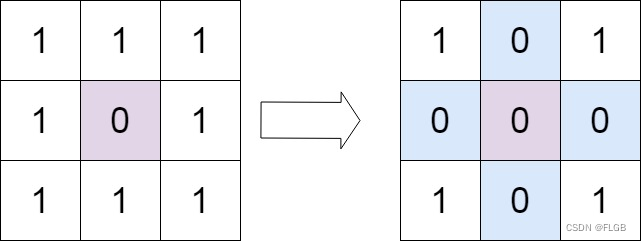算法-【矩阵】73. 矩阵置零【中等】
推荐 原创矩阵置零
- 给定一个 m x n 的矩阵,如果一个元素为 0 ,
- 则将其所在行和列的所有元素都设为 0 。请使用 原地 算法。
示例 1:

输入:matrix = [[1,1,1],[1,0,1],[1,1,1]]
输出:[[1,0,1],[0,0,0],[1,0,1]]
解题思路
- 1、使用矩阵的第一行和第一列来标记对应的行和列是否需要置零。
- 2、遍历矩阵,如果某个元素 matrix[i][j] 为 0,则将第一行第 j 列和第一列第 i 行的元素置零,用于标记对应的行和列需要置零。
- 3、再次遍历矩阵,将除第一行和第一列之外的行和列置零,根据第一行和第一列的标记。
- 4、最后,根据第一行和第一列的标记,确定是否需要置零第一行和第一列。
Java实现
public class ZeroMatrix {
public static void setZeroes(int[][] matrix) {
boolean firstRowZero = false;
boolean firstColZero = false;
// 检查第一行是否有0
for (int j = 0; j < matrix[0].length; j++) {
if (matrix[0][j] == 0) {
firstRowZero = true;
break;
}
}
// 检查第一列是否有0
for (int i = 0; i < matrix.length; i++) {
if (matrix[i][0] == 0) {
firstColZero = true;
break;
}
}
// 使用第一行和第一列来记录其他行列是否需要置0
for (int i = 1; i < matrix.length; i++) {
for (int j = 1; j < matrix[0].length; j++) {
if (matrix[i][j] == 0) {
matrix[i][0] = 0;
matrix[0][j] = 0;
}
}
}
// 根据记录,置0其他行列
for (int i = 1; i < matrix.length; i++) {
for (int j = 1; j < matrix[0].length; j++) {
if (matrix[i][0] == 0 || matrix[0][j] == 0) {
matrix[i][j] = 0;
}
}
}
// 根据标记决定是否将第一行置为0
if (firstRowZero) {
for (int j = 0; j < matrix[0].length; j++) {
matrix[0][j] = 0;
}
}
// 根据标记决定是否将第一列置为0
if (firstColZero) {
for (int i = 0; i < matrix.length; i++) {
matrix[i][0] = 0;
}
}
}
public static void main(String[] args) {
int[][] matrix = {
{
1, 2, 3, 4},
{
5, 0, 7, 8},
{
9, 10, 11, 12},
{
0, 14, 15, 16}
};
System.out.println("原始矩阵:");
printMatrix(matrix);
setZeroes(matrix);
System.out.println("\n置零后的矩阵:");
printMatrix(matrix);
}
public static void printMatrix(int[][] matrix) {
for (int[] row : matrix) {
for (int num : row) {
System.out.print(num + " ");
}
System.out.println();
}
}
}
时间空间复杂度
- 时间复杂度:O(m * n),其中 m 和 n 分别是矩阵的行数和列数
- 空间复杂度:O(1),使用常数级别的额外空间
更多【算法-【矩阵】73. 矩阵置零【中等】】相关视频教程:www.yxfzedu.com
相关文章推荐
- 电脑-电脑硬盘数据恢复哪个好?值得考虑的 8 个硬盘恢复软件解决方案 - 其他
- jvm-内存管理 - 其他
- 算法-吴恩达《机器学习》7-1->7-4:过拟合问题、代价函数、线性回归的正则化、正则化的逻辑回归模型 - 其他
- 前端-vue项目js原生属性IntersectionObserver实现图片懒加载 - 其他
- 编程技术-Python标准库有哪些 - 其他
- 编程技术-读取W25Q64的设备ID时输出0xff - 其他
- 金融-可以写进简历的软件测试项目(银行/金融/电商/商城......) - 其他
- 百度-想要创建百度百科词条怎么做? - 其他
- c#-C#基于inpoutx64读写ECRAM硬件信息 - 其他
- java-JavaScript如何实现钟表效果,时分秒针指向当前时间,并显示当前年月日,及2024春节倒计时,源码奉上 - 其他
- c++-Linux驱动应用层与内核层之间的数据传递 - 其他
- 人工智能-读书笔记:彼得·德鲁克《认识管理》第11章 若干例外及经验教训 - 其他
- 运维-短时间不点击云服务器,自动化断开连接,怎么设置长时间 - 其他
- 运维-Rocky Linux 配置邮件发送 - 其他
- 编程技术-数码管动态扫描 - 其他
- 编程技术-编程语言的基本元素 - 其他
- pandas-人工智能基础——python:Pandas与数据处理 - 其他
- 编程技术-2、鸿蒙开发工具首次运行时开发环境配置 - 其他
- 编程技术-WEB代码审计 - 其他
- 编程技术-苹果开发者证书生成实操流程 - 其他
记录自己的技术轨迹
文章规则:
1):文章标题请尽量与文章内容相符
2):严禁色情、血腥、暴力
3):严禁发布任何形式的广告贴
4):严禁发表关于中国的政治类话题
5):严格遵守中国互联网法律法规
6):有侵权,疑问可发邮件至service@yxfzedu.com
近期原创 更多
